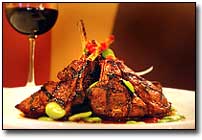
The first time Andina’s Peter Platt heard it said that the three great cuisines of the world were French, Chinese and Peruvian, he was a bit taken back as well. “I was pretty surprised to hear him say that,” said Peter of a good friend of his who also happens to be a chef. Not that he didn’t already appreciate “the first great, original fusion cuisine,” as he puts it, but to hear the relatively little-known food that his mother had served him growing up in Corvallis referred to as one of the world’s greatest helped to add perspective to a pride he already took in his heritage.
Son of Peru RPCV John Platt wins prize for Peruvian Restaurant in Portland Oregon
Peak of flavor
By Jake TenPas
Gazette-Times reporter
Photos courtesy of Andina Restaurant
Diners relax in Andina’s Bar Mestizo, which features music ranging from Brazilian jazz to traditional Cuban sounds in addition to an extensive cocktail menu.
From the Andes to the Cascades, Corvallis family brings flavors of Peru to Portland
Quickly, name the three great cuisines of the world.
While there are as many answers to this question as there are cultures on our planet, some seem to wash right to the tip of the tongue: French, Chinese, Italian, Japanese and so forth.
And while there’s no wrong answer to the question, save perhaps British food, certain answers are likely to be forgotten if they were ever known at all.
Take the food of Peru, for instance.
Unless you’ve traveled to the coastal South American nation, are fortunate enough to know a cook skilled in its culinary traditions or have stumbled upon the best restaurant in Portland’s Pearl District, Andina, chances are it didn’t make your list.
That’s just fine.
The first time Andina’s Peter Platt heard it said that the three great cuisines of the world were French, Chinese and Peruvian, he was a bit taken back as well.
“I was pretty surprised to hear him say that,” said Peter of a good friend of his who also happens to be a chef. Not that he didn’t already appreciate “the first great, original fusion cuisine,” as he puts it, but to hear the relatively little-known food that his mother had served him growing up in Corvallis referred to as one of the world’s greatest helped to add perspective to a pride he already took in his heritage.
“We see ourselves functioning as a cultural embassy that also serves food,” said the almost painfully intelligent renaissance man at a table in the high-ceilinged, brightly adorned Bar Mestizo section of Andina. Wherever you wander throughout the restaurant, you are greeted with images of Peru, its culture and its people. From the gritty black and white photographs and abstract paintings that surround the eating area, to the vintage psychedelic propaganda posters and vases stuffed with dried flowers and chili peppers, every conceivable vantage point offers a visual reminder that you are venturing beyond the borders of America.
Perhaps none more so than the plates placed in front of you when you order. Whether you’re sitting down to one of Andina’s traditional or novoandina entrees, or just sampling a few of their tapas plates with one of their original alcoholic concoctions, every vessel that’s set in front of you invites you to step outside of yourself and sample the flavors of a culture that dates back 8,000 years.
The history
To have a conversation about Peruvian food with Peter and his mother, Doris, is to sit down to a history lesson every bit as interesting as the flavors it has resulted in. To try to recount that lesson is to try to describe the taste of their Seco de Cordero, a simmered lamb stew served with spiced beans and rice — a futile task at best.
“The cuisine of Peru encompasses every culture,” Peter said. “Colonialism brought European cuisine to Peru,” which in turn smuggled in the flavors of the Mediterranean region and Arabic world that had become hopelessly mixed up with it.
After the Moors invaded Spain, they left behind their use of spices such as nutmeg, coriander and cinnamon, which after making their way across the ocean became a part of Peru’s already diverse palate.
Of course, this is the neat, happy version of history, and very different from the reality. In truth, the Spanish conquered and subjugated the Incas of Peru, banning many of the staples of their diet such as tomatoes and potatoes, which they perceived as evil or poisonous. Then, in a strange, circular turn of events, such foods became popular in the royal courts of France, which spread back to Peru through the colonial pipeline. And that’s just one story of many.
Peru is the world’s second-largest fishery behind China, and has always been a fertile breeding ground for creatures of the sea and air alike. As the fish feed on the plankton in the ocean, the seabirds living nearby gorge themselves on the fish. In turn, the sometimes disturbing number of birds results in one of the world’s largest deposits of guano, or droppings.
“It’s kind of gross, but pretty fascinating,” comments Peter.
In the early 1800s, this made Peru a prime target for European colonial powers, who were desperately searching for fertilizer to replace the nitrogen leached from their soil by their favored crops. After winning their independence from Spain, the people of Peru found that they were in dire need of money, for which they leased their guano-rich islands to England in exchange for the funds to build railroads across their country.
When German scientists discovered a way to synthesize the chemical compounds in fertilizer, the islands, which had become greatly devalued, were returned to Peru.
Though that particular batch of Europeans pulled out of Peru, it wasn’t the last time foreign powers would find natural resources in and around the Andes worth pillaging.
“Now we are a colony in different ways,” Doris said, elaborating on the fact that gold and silver mines in the mountain range have been the most recent draw of outside interests. In fact, it was upon returning from a Mercy Corps mission to help resolve a conflict between a mining company and a local municipality that a friend of Peter’s first suggested the idea of opening a Peruvian restaurant in Portland.
After consulting with his family, Peter decided this might be the best way to “rediscover and reinherit the lost crafts of the Incas.”
“We wanted to create an idea, a distillation of what Peru is,” he said.
The Family
When Peter first approached his parents with this idea for a way to celebrate the fusion of flavors that his culture represents, his Mom had some valid concerns — not the least of which was that her son had no experience in the restaurant business.
“His idea, I was thinking, will be crazy,” she said in her regal Peruvian accent. Despite her reservations; however, she came to the conclusion that she must let him learn for himself.
Learning and thinking for oneself was a concept she had first emphasized during her time as a science teacher in Peru, where the revolutionary spirit of the late ’60s ignited a desire among her country’s intellectuals to raise a generation of youngsters who would be immune to the emotional manipulation favored by its politicians.
It was during the era of the Vietnam War, when Socialism was helping to shape a new national identity in Peru, that Doris met John Platt, a Peace Corps volunteer who had come to her country to combat stereotypes of the United States by spreading peace and positivity to the world, she remembers.
The two came together through shared idealism and were soon married. In 1976 and ’77, their first two sons, John and Peter, were born, but around that time the Socialist government fell out of power. As the new regime took control and the country’s official mission statements began to mutate accordingly, John stopped being hired, and the family decided to move back to the United States
Despite the nature of their departure, Doris recalls John saying, “I received more than I gave.”
After a brief stay with his parents in Portland, the Platts headed for Corvallis, where John worked at Hewlett-Packard, and the family found a great school system for their growing children.
“We found in Corvallis a home,” recalls Doris. “People were very welcoming.”
The Food
Inspired by the love of his parents and the combination of his experiences in the United States and Peru, Peter leapt at the chance to open an eatery that would honor both traditions. His goal was to create a menu and a physical structure to serve it in that would convey a sense of the pride his family always took in the way they presented hospitality to their guests.
The Platt family then enlisted the help of designer Paul Scardina and founding chef Emmanuel Piqueras Villaran to bring to life their vision of a cultural embassy that also served food.
The results are astounding.
Andina was named Restaurant of the Year 2005 by The Oregonian, but you don’t have to be a food critic to appreciate the big yet subtle flavors or classic decor of the place. Bare rafters flow overhead as avocado and terracota walls create a sense of openness that is balanced by the cozy lighting created by paper lamps hanging above the tables.
Despite the Platts’ claim that food is just a part of the experience, it must be pointed out that it is the best part, even when it’s served to the sonic backdrops of Brazilian jazz, traditional Puerto Rican or Cuban music, or even contemporary experimental Latin sounds. Regardless of the backdrop, it’s all about what’s in the foreground: the simultaneously traditional and innovative cuisine.
A meal might begin with a salad of field greens, avocado, onions, tomatoes, cotija cheese, palm hearts and corn, which balances the creamier flavors of some of its ingredients with the tang of vinaigrette. Accompanying this is a basket of fresh bread with a long, narrow glass plate holding three types of dipping sauces: a peanut and cheese sauce for those who like to avoid serious spice, a habanero-passion fruit puree for the more adventurous and a jalapeno-mint paste for people such as myself, who actually enjoy food that makes them sweat.
From there, you can either indulge in a sampling of their tapas platters, which range in size and price from small, which serves one person, to large, which can serve roughly four. Such appetizers include marinated chicken and beef heart kabobs, scallops baked with parmesan cheese, sausage and cheese plates with quince jam and an array of Cebiches de la Casa, or raw foods “cooked” in key lime or other citrus juices and marinaded in onions, cilantro, hot pepper and sea salt.
My favorite of the tapas was their Tabule de Cereales Andinos, a creative take on the classic mediterranean dish of Tabouli. Andina’s version is a buttery and yet tart concoction of quinoa grain, avocado, tomatoes, cukes, onions and palm hearts.
Or, if you’d rather just jump into the main course, Andina has some original dishes to offer you. From fresh halibut drizzled with a butter and pepper sauce and served with roasted butternut squash, spinach and finger potatoes, to artichokes and asparagus on a bed of quinoa and wild mushroom “risotto” laced with white truffle oil, they offer the perfect salve for a variety of tastebuds afflicted with hunger.
And while you’re eating, why not chase it with one of their luscious cocktails, such as the traditional Pisco Sour or the adventurous Granada de Amor, a romantic mixture of Ketel One Citroen vodka, pomegranate, Domiana (which the menu describes as Mexican love potion), key lime and a hint of cinnamon.
Blending of cultures
No matter what you try at Andina, you can be sure care was taken not only in its preparation, but also in the selection of the ingredients used to make it.
The Platts have gone to great lengths “to honor the ingredient-focused culture of Portland,” while also respecting the native flavors of Peru. Through a combination of imported ingredients and teaching local farmers to grow specific Peruvian herbs and spices, the family behind the restaurant Willamette Week says delivers “sensuous culinary pleasure” is serious about bridging the two cultures in an environmentally friendly fashion.
“Why should we become an ethnic restaurant isolated from the community?” asks Peter, as the answer practically supplies itself.
Doris adds, “We see a good way to share with the people of the Northwest our culture, and to honor our country.”
As North America continues to see an influx of Latin Americans, their languages, food, art and customs, Andina serves as a model for the beauty that the splicing of the two heritages can result in. And if the newest star of the Pearl District is any indicator, the mixture of the two will be stronger and more pleasing to the palate than either were on their own.
“We try to stimulate as many of the senses as possible,” Peter said. In doing so, Andina is moving Peruvian food closer to being recognized as one of the great cuisines of the world one diner at a time.
If you go
WHAT: Andina Restaurant, Peruvian cuisine
WHERE: 1314 N.W. Glisan St., Portland, in the Pearl District
Phone: For information or reservations, call 503-228-9535
Jake TenPas edits the Entertainer. He can be reached at 758-9514 or jake.tenpas@lee.net.














